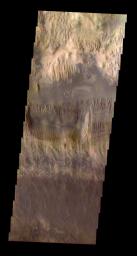
|
Hebes Mensa
- Click the image above for a larger view
- Full-Res JPEG (734 x 1370) (98.0 kB)
- Full-Res TIFF (734 x 1370) (2.0 MB)
Caption:
Released 10 June 2004This colorization is the result of a collaboration between THEMIS team members at Cornell University and space artist Don Davis, who is an expert on true-color renderings of planetary astronomical objects. Davis began with calibrated and co-registered THEMIS VIS multi-band radiance files produced by the Cornell group. Using as a guide true-color imaging from the Hubble Space Telescope and his own personal experience at Mt. Wilson and other observatories, he performed a manual color balance to match more closely the colors of previous visual Mars observations. He also did some manual smoothing and other image processing to mimimize the effects of residual scattered light in the images. The result is a view of Mars that invites comparisons to Earth; a scene that one might observe out the window on a flight over the southwest United States, but not quite.
Initial image processing and calibration by THEMIS team members J. Bell, T. McConnochie, and D. Savransky at Cornell University; additional processing and final color balance by space artist Don Davis.
Image information: VIS instrument. Latitude -0.7°, Longitude 282.9° East (77.1%deg; West). 19 meter/pixel resolution.
The THEMIS VIS camera is capable of capturing color images of the martian surface using its five different color filters. In this mode of operation, the spatial resolution and coverage of the image must be reduced to accommodate the additional data volume produced from the use of multiple filters. To make a color image, three of the five filter images (each in grayscale) are selected. Each is contrast enhanced and then converted to a red, green, or blue intensity image. These three images are then combined to produce a full color, single image. Because the THEMIS color filters don't span the full range of colors seen by the human eye, a color THEMIS image does not represent true color. Also, because each single-filter image is contrast enhanced before inclusion in the three-color image, the apparent color variation of the scene is exaggerated. Nevertheless, the color variation that does appear is representative of some change in color, however subtle, in the actual scene. Note that the long edges of THEMIS color images typically contain color artifacts that do not represent surface variation.
Image information: VIS instrument. Latitude -0.7°, Longitude 282.9° East (77.1%deg; West). 19 meter/pixel resolution.
Note: this THEMIS visual image has not been radiometrically nor geometrically calibrated for this preliminary release. An empirical correction has been performed to remove instrumental effects. A linear shift has been applied in the cross-track and down-track direction to approximate spacecraft and planetary motion. Fully calibrated and geometrically projected images will be released through the Planetary Data System in accordance with Project policies at a later time.
Background Info:
NASA's Jet Propulsion Laboratory manages the 2001 Mars Odyssey mission for NASA's Office of Space Science, Washington, D.C. The Thermal Emission Imaging System (THEMIS) was developed by Arizona State University, Tempe, in collaboration with Raytheon Santa Barbara Remote Sensing. The THEMIS investigation is led by Dr. Philip Christensen at Arizona State University. Lockheed Martin Astronautics, Denver, is the prime contractor for the Odyssey project, and developed and built the orbiter. Mission operations are conducted jointly from Lockheed Martin and from JPL, a division of the California Institute of Technology in Pasadena.
Cataloging Keywords:
| Name | Value | Additional Values |
|---|---|---|
| Target | Mars | |
| System | ||
| Target Type | Planet | |
| Mission | 2001 Mars Odyssey | Hubble Space Telescope (HST) |
| Instrument Host | Mars Odyssey | Hubble Space Telescope |
| Host Type | Orbiter | Space Telescope |
| Instrument | Thermal Emission Imaging System (THEMIS) | |
| Detector | ||
| Extra Keywords | Artwork, Color, Thermal | |
| Acquisition Date | ||
| Release Date | 2004-06-10 | |
| Date in Caption | ||
| Image Credit | NASA/JPL/Arizona State University/Cornell/Don Davis | |
| Source | photojournal.jpl.nasa.gov/catalog/PIA06389 | |
| Identifier | PIA06389 | |
